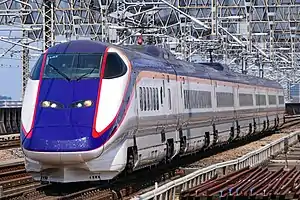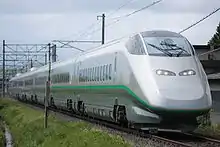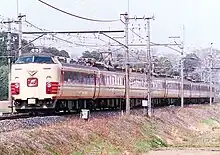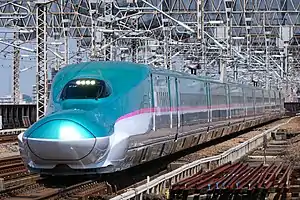 A reliveried E3-2000 series set on a Tsubasa service, May 2022 | |
| Overview | |
|---|---|
| Service type | Shinkansen |
| Locale | Japan |
| First service | 1 October 1961 (Limited express) 1 July 1992 (Shinkansen) |
| Current operator(s) | JR East |
| Former operator(s) | JNR |
| Route | |
| Termini | Tokyo Shinjo |
| Average journey time | 3 hrs 11 minutes (fastest) |
| Service frequency | 16 return trips daily |
| On-board services | |
| Catering facilities | Trolley service |
| Technical | |
| Rolling stock | E3 series |
| Track gauge | 1,435 mm (4 ft 8+1⁄2 in) |
| Electrification | 25 kV AC overhead |
| Operating speed | 275 km/h (170 mph) |
The Tsubasa (つばさ) is a high-speed Shinkansen train service operated on the Yamagata Shinkansen by East Japan Railway Company (JR East) since July 1992. The name was formerly used for a limited express service operated by Japanese National Railways (JNR) and later by JR East, which ran from Ueno to Akita, and was discontinued in 1992 when the new shinkansen service commenced.
The Japanese word "tsubasa" means "wing".
Service outline
The services were originally operated by 7-car 400 series trains, later replaced by 7-car E3 series trains. They couple with E2 series trains for their journey from Tokyo to Fukushima, traveling at a maximum speed of 275 km/h (170 mph). Tsubasa trains are limited to 130 km/h (80 mph) on the Yamagata Shinkansen from Fukushima to Shinjō since there are many sharp curves and level crossings, as the line is essentially a re-gauged narrow-gauge line.
Train formations
Tsubasa services are operated by 7-car E3 series trainsets, with car 11 at the Tokyo end. All seats are no-smoking.[1]
| Car No. | 11 | 12 | 13 | 14 | 15 | 16 | 17 |
|---|---|---|---|---|---|---|---|
| Accommodation | Green car | Reserved | Reserved | Reserved | Reserved | Non-reserved | Non-reserved |
| Facilities | Wheelchair space | Wheelchair space | Cardphone | Cardphone |
Rolling stock
Tsubasa services are operated using a fleet of three E3-1000 series and twelve E3-2000 series 7-car trains. The latter were phased in from December 2008, totally replacing the older 400 series trains from April 2010.
 400 series, March 2008
400 series, March 2008 E3-1000 series, April 2011
E3-1000 series, April 2011 E3-2000 series, May 2009
E3-2000 series, May 2009
History
Limited express service (1961–1992)
The Tsubasa service commenced from the start of the revised timetable on 1 October 1961 as a limited express operating between Ueno in Tokyo and Akita, using new KiHa 80 series diesel multiple unit (DMU) trains in 6-car formations.[2] Initially, there was one return service daily, with a journey time of exactly 8 hours 30 minutes in either direction, cutting two hours off the journey time for the previous direct express service between Ueno and Akita.[2] The outward service departed from Ueno at 12:30, arriving at Akita at 21:00. The return service departed from Akita at 08:10, arriving at Ueno at 16:40.[2]
From April 1963, the trains were increased from 6 to 7 cars to cope with the popularity of the service, and from 5 December of the same year, an additional unit was added to the formation when running between Ueno and Morioka.[2]
From the start of the October 1968 timetable revision, services were extended to run to and from Tokyo Station, and KiHa 81 driving cars formerly used on Hatsukari services were added to the formations.[2]
In February 1970, the KiHa 80 series trains were replaced by KiHa 181 series 10-car DMU formations, which were capable of running at a maximum speed of 120 km/h on the main line. In July 1971, these formations were lengthened to 12 cars.[2]

In October 1975, electrification of the Ou Main Line was completed, and from the start of the revised timetable on 25 November, the KiHa 181 series DMUs were replaced on Tsubasa services by 485 series electric multiple unit (EMU) trains. From the start of the revised timetable in October 1978, three return workings operated daily, with non-reserved cars also included for the first time.[2]
Service patterns were revised following the opening of the Tohoku Shinkansen in November 1982. Service frequency was increased to five trains in each direction daily, but most services were cut back to operate between Fukushima and Akita, with only one down service and two up services remaining between Ueno and Akita.[2]
Shinkansen service (1992–)
From 1 July 1992, the Tsubasa name was transferred to new high-speed shinkansen services operating between Ueno and Yamagata. Services used 6-car 400 series trains coupled to a 200 series on Tōhoku Shinkansen tracks between Tokyo and Fukushima. Initially, there were 14 return workings daily.[2] From December 1993, all trains were extended to start and terminate at Tokyo Station, and in December 1994, service frequency was increased from 14 to 15 return workings daily.[2]
From 1 December 1995, trains were extended to 7 cars.[2]
From 4 December 1999, Tsubasa services were extended to Shinjō Station, with the fastest service (Tsubasa 113) taking 3 hours 5 minutes.[2] Two new E3-1000 series sets (L51 and L52) were also added to the fleet.
From 21 September 2001, double-decker E4 series replaced the 200 series trains on the Tōhoku Shinkansen.
In 2005, a third E3-1000 series trainset (L53) entered service.
From 18 March 2007, all cars were made non-smoking.
From 20 December 2008, new E3-2000 series trains entered service, replacing 400 series trainsets.[3] The last 400 series set (L3) in service was withdrawn on 18 April 2010.
From the start of the revised timetable on 17 March 2012, nine out of sixteen daily Tsubasa services run coupled with Yamabiko services formed of E2 series trains, instead of E4 series sets, allowing the maximum speed to be raised from 240 km/h to 275 km/h on the Tōhoku Shinkansen tracks, and shaving up to 6 minutes off journey times between Tokyo and Shinjō.[4]
Since the start of the revised timetable on 29 September 2012, all sixteen daily Tsubasa services run coupled with E2 series Yamabiko trains, allowing the maximum speed of all services to be raised from 240 km/h to 275 km/h.[5]
From spring 2014, the entire fleet of fifteen E3-1000 and E3-2000 series sets used on Tsubasa services are scheduled to be reliveried in a new colour scheme designed by industrial designer Ken Okuyama.[6] Three sets are scheduled to be repainted by June 2014, with the entire fleet of fifteen sets repainted by mid 2016.[6]
From the start of the revised timetable on 16 March 2024, E8 series sets are scheduled to be introduced on Tsubasa services, progressively replacing the existing E3 series sets and allowing the maximum top speed to be increased from 275 to 300 kilometers per hour (171 to 186 mph).[7]
See also
References
- ↑ JR Timetable, October 2013 issue, p. 992
- 1 2 3 4 5 6 7 8 9 10 11 12 Teramoto, Mitsuteru (July 2001). 国鉄・JR列車名大辞典 [JNR & JR Train Name Encyclopedia]. Tokyo, Japan: Chuoshoin Publishing Co., Ltd. pp. 361–363. ISBN 4-88732-093-0.
- ↑ "山形新幹線に新型車両" (New Trains for Yamagata Shinkansen). (20 December 2008) Archived 13 July 2012 at archive.today. Retrieved on 20 December 2008. (in Japanese)
- ↑ 2012年3月ダイヤ改正について [March 2012 Timetable Revision] (PDF) (in Japanese). Japan: East Japan Railway Company. 16 December 2011. Retrieved 16 December 2011.
- ↑ 2012年9月ダイヤ改正について [September 2012 Timetable Revision Details] (PDF) (in Japanese). Japan: East Japan Railway Company. 6 July 2012. p. 1. Retrieved 6 July 2012.
- 1 2 山形新幹線 「つばさ」塗装リニューアル [Yamagata Shinkansen Tsubasa trains to be repainted]. Kahoku Online Network (in Japanese). Japan: Kahoku Shimpo Publishing. 29 August 2013. Archived from the original on 1 September 2013. Retrieved 30 August 2013.
- ↑ "JR東日本,E8系"つばさ"の運転を3月16日から開始" [E8 Series Shinkansen to Enter Service 16 March 2024]. Japan Railfan Magazine Online (in Japanese). 15 December 2023. Archived from the original on 15 December 2023. Retrieved 17 December 2023.
External links
- JR East E3 series Tsubasa (in Japanese)



